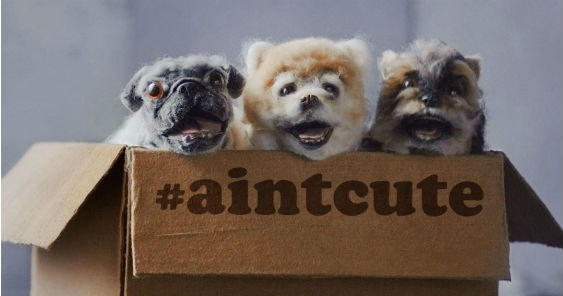SAO PAOLO –That adorable puppy you see at pet shops, all groomed and wearing a ribbon, will just about make anyone want to take it home. But do you know how it got there? It may have been through some hard times before reaching the shop window, warns the new “Ain’t cute” campaign by the Animal Hope Project (PEA). The action calls attention to a recurrent theme in a Brazilian’s daily life, but one that often goes unnoticed: the illegal breeding and raising of animals and cases of animal cruelty that go on behind closed doors in the pet trade.
The film, created by the ad agency Leo Burnett Tailor Made, shows that amid filthy, crowded cages and diseases, females are made to copulate more than five times a day. They even mate with their own offspring and are then discarded. The scenes, which are animations, go on to show puppies that are blind, deaf, and even without paws, all the result of irresponsibility; and that – to avoid expenses – the animals are almost never vaccinated and can die before reaching three months of age. The survivors of this series of mistreatments are those little pups in the display windows waiting for an owner.
The campaign encourages the adoption of animals and seeks to show the public that they are often as much a victim as the animals themselves for not knowing what happens to these pedigree puppies before they are bought. That’s what the lyrics of the film’s soundtrack tells us, as interpreted by the puppies themselves at a bouncy rhythm reminiscent of Broadway musicals.
“The practice of illegally breeding and selling puppies is common in large Brazilian cities. The government, unfortunately, has neither the people nor the resources for this fight, and a lenient legislation does little to inhibit those who sell animals on the streets. Illegal breeding is difficult to control because it occurs inside people’s homes, often on rural properties or warehouses. Only when neighbors make a complaint – due either to the loud barking and crying of dogs or to the foul smell – can the health surveillance authorities or the police locate and identify these places. Many of the animals on display in pet shops come from illegal breeders and as the animals have no serial number, it is impossible to identify their place of origin,” says Carlos Rosolen, CEO for PEA.
ABANDONED PETS
The film shows yet another reality behind the animal trade; the abandoning of pets after their purchase. According to IBGE (a Brazilian statistical institution), Brazil’s 132 million pets make it the country with the fourth greatest number of pets; and the second in number of pet dogs, with 52 million in 2013. The World Health Organization estimates that in Brazil alone, there are over 30 million abandoned animals, 20 million of which are dogs. There is one dog for every five inhabitants in large cities. Of these, 10% are abandoned. The situation is not much different in smaller towns in the countryside. In many cases, the number reaches 1/4 that of the human population.
In April last year, the House of Representatives approved a bill that makes threatening the physical or mental health of dogs and cats a crime. Currently, the law punishes with three months’ to a year’s open or semi-open detention whoever mistreats, injures, or mutilates an animal. The sentence is extended by one sixth to one third if the crime causes the animal’s death. Under the proposal, the sentence for killing any one of these animals will be 1 to 3 years imprisonment and can be extended by a third if the crime is committed using poison, fire, suffocation, beatings, dragging, torture, or any other form of cruelty; and doubled, if more than two people commit the crime or if it is committed by the pet owner. The proposal also criminalizes the abandonment of dogs and cats, with three to twelve months’ imprisonment.








